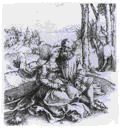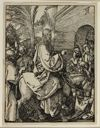Albrecht Dürer
German
(Nuremberg, Germany, 1471 - 1528, Nuremberg, Germany)
The leading figure of German Renaissance art, Albrecht Dürer, is celebrated for introducing the forms and ideas of the Italian Renaissance into Northern Europe. In art and in life, Dürer continually strived for perfection. Describing the artist in 1532, in the preface to his Latin translation of the artist’s treatise on human proportion, humanist scholar Joachim Camerarius (1500-1574) praised his character as highly as his art and said that his only vice was being so self-critical that he could never cease researching a thing.
A combination of prodigious artistic talent and a restless desire to learn made the goldsmith’s son from Nuremberg one of the foremost chroniclers of his age. He traveled widely by the standards of his time—to Colmar, Basel, and Strasbourg, perhaps by way of Frankfurt am Main and Mainz (1490-94), to Italy (1494-95 and 1505-1507) and to the Netherlands (1520-21). In addition to a journal of his trip to the Netherlands, letters, and records of various kinds, Dürer left to posterity about 2,000 drawings and watercolors depicting the work of other artists, the countenances of both famous and anonymous contemporaries, local and foreign costumes, landscapes, plants, animals, his own artistic inventions, even one of his dreams and his own nude body. Not content with his remarkable ability to represent the world as it appeared to his eyes, Dürer delved beneath the surface for the mathematical order of God’s universe. Thus from about 1500 until the end of his life, he studied perspective and human and animal proportions, eventually authoring Manual of Measurement (1525) and Four Books on Human Proportion (published posthumously in 1528 by his widow).
Although Dürer was not university-educated, his exceptional capacity for friendship gained him access to humanist circles ordinarily closed to a craftsman’s son and to advanced learning that found visual expression in his art—an oeuvre of about seventy paintings and hundreds of prints that encompasses mythological and allegorical subjects in addition to portraits and traditional Christian themes. Respected for his ideas as much as for his manual skills, Dürer also designed diverse objects to be made by others, including stained-glass windows, large-scale bronze sculpture, armor, table fountains, goblets, jewelry, chandeliers, and ceremonial robes. He strived for knowledge in areas other than the visual arts, taking dancing lessons in Venice in 1506, trying his hand at poetry, and publishing a book on fortification in 1527.
Dürer initially trained as a goldsmith with his father, Albrecht Dürer the Elder (1427-1502), from 1485 to 1486. From 1486 to 1489 he was apprenticed to the painter Michael Wolgemut (1434/7-1519) in Nuremberg’s largest workshop for altarpieces and woodcut illustrations.
The work that best epitomizes the young Dürer’s artistic ambitions and religious concerns dates from the late 1490s. The Apocalypse (1498) is a book of woodcuts, including the famous Four Horsemen, and biblical text from Revelation. Dürer, who was the godson of the most important publisher in Germany, Anton Koberger (c. 1445-1513), proudly identified himself as both artist and publisher of this book, this dual role being a first in the history of art. Its fifteen 15-by-11-inch prints gave visual expression to contemporary fears of the arrival in 1500 of the millennium, the thousand years mentioned in Revelations during which Christ would reign on earth following a cosmic cataclysm destroying the forces of evil. Dürer, most likely with the aid of professional block cutters, wrested from the recalcitrant wood a degree of naturalism that undoubtedly was astonishing at the time. This publication was followed by two others: the Large Passion (1511), and the Life of the Virgin (1511). Together these books form the so-called die grossen Bücher (or large books).
Salvation is the theme of the artist’s so-called “master engravings,” Knight, Death and the Devil (1513), Melencolia I (1514), and St. Jerome in His Study (1514). Along with the Adam and Eve (1504) of a decade earlier, the three engravings are unmatched achievements of the engraver’s art, compelling in the articulation of textured surfaces and in the nuanced play of light—the sheen of the Christian knight’s steed in a shadowy forest, the brilliance of a comet in the night sky above Melancholy, and the reflection of light through the bottle-glass windows of St. Jerome’s study.
Dürer’s ability to suggest a variety of textures in his engravings was undoubtedly the reward of countless hours of experimentation with the burin. The highly organized hatching and cross-hatching systems, the result of the artist’s extraordinary control of the engraver’s tool and his emulation of the great Colmar engraver Martin Schongauer (c. 1450-1491), lend an awe-inspiring stillness even to early prints such as Madonna with the Monkey, c. 1498.
Dürer’s artistic striving cannot be separated from his search for spiritual improvement. Like many of his contemporaries, he seems to have been an adherent of the devotio moderna, a popular form of piety that centered on the fifteenth-century devotional work The Imitation of Christ. Dürer’s desire to place Christ at the center of his life is vividly expressed in his famous Self-Portrait in oils of 1500 (Munich, Alte Pinakothek). By idealizing his features to conform with depictions of Jesus and painting the reflection of a window cross in his eyes, he identified himself as one who has taken up the cross of Christ, his “compass to paradise.” In accordance with humanist belief in the dignity of man, Dürer depicted himself not only as created in God’s image (Genesis 1:27), but also with his right hand prominently displayed, as one who could use his God-given talents to create in a manner akin to the Almighty. Dürer died on April 6, 1528.
Biography excerpted from Barbara Butts, "A Compass to Paradise: Albrecht Dürer and His Search for Beauty and Salvaion". Published in Faith and Humanism: Engravings and Woodcuts by Albrecht Dürer, Montgomery Museum of Fine Arts, 2002.
Image credit: Albrecht Dürer (Dutch, 1471–1528), Self-portrait, 1498, oil on panel, Courtesy of the Museo del Prado, (c) CC-by-PD
German
(Nuremberg, Germany, 1471 - 1528, Nuremberg, Germany)
The leading figure of German Renaissance art, Albrecht Dürer, is celebrated for introducing the forms and ideas of the Italian Renaissance into Northern Europe. In art and in life, Dürer continually strived for perfection. Describing the artist in 1532, in the preface to his Latin translation of the artist’s treatise on human proportion, humanist scholar Joachim Camerarius (1500-1574) praised his character as highly as his art and said that his only vice was being so self-critical that he could never cease researching a thing.
A combination of prodigious artistic talent and a restless desire to learn made the goldsmith’s son from Nuremberg one of the foremost chroniclers of his age. He traveled widely by the standards of his time—to Colmar, Basel, and Strasbourg, perhaps by way of Frankfurt am Main and Mainz (1490-94), to Italy (1494-95 and 1505-1507) and to the Netherlands (1520-21). In addition to a journal of his trip to the Netherlands, letters, and records of various kinds, Dürer left to posterity about 2,000 drawings and watercolors depicting the work of other artists, the countenances of both famous and anonymous contemporaries, local and foreign costumes, landscapes, plants, animals, his own artistic inventions, even one of his dreams and his own nude body. Not content with his remarkable ability to represent the world as it appeared to his eyes, Dürer delved beneath the surface for the mathematical order of God’s universe. Thus from about 1500 until the end of his life, he studied perspective and human and animal proportions, eventually authoring Manual of Measurement (1525) and Four Books on Human Proportion (published posthumously in 1528 by his widow).
Although Dürer was not university-educated, his exceptional capacity for friendship gained him access to humanist circles ordinarily closed to a craftsman’s son and to advanced learning that found visual expression in his art—an oeuvre of about seventy paintings and hundreds of prints that encompasses mythological and allegorical subjects in addition to portraits and traditional Christian themes. Respected for his ideas as much as for his manual skills, Dürer also designed diverse objects to be made by others, including stained-glass windows, large-scale bronze sculpture, armor, table fountains, goblets, jewelry, chandeliers, and ceremonial robes. He strived for knowledge in areas other than the visual arts, taking dancing lessons in Venice in 1506, trying his hand at poetry, and publishing a book on fortification in 1527.
Dürer initially trained as a goldsmith with his father, Albrecht Dürer the Elder (1427-1502), from 1485 to 1486. From 1486 to 1489 he was apprenticed to the painter Michael Wolgemut (1434/7-1519) in Nuremberg’s largest workshop for altarpieces and woodcut illustrations.
The work that best epitomizes the young Dürer’s artistic ambitions and religious concerns dates from the late 1490s. The Apocalypse (1498) is a book of woodcuts, including the famous Four Horsemen, and biblical text from Revelation. Dürer, who was the godson of the most important publisher in Germany, Anton Koberger (c. 1445-1513), proudly identified himself as both artist and publisher of this book, this dual role being a first in the history of art. Its fifteen 15-by-11-inch prints gave visual expression to contemporary fears of the arrival in 1500 of the millennium, the thousand years mentioned in Revelations during which Christ would reign on earth following a cosmic cataclysm destroying the forces of evil. Dürer, most likely with the aid of professional block cutters, wrested from the recalcitrant wood a degree of naturalism that undoubtedly was astonishing at the time. This publication was followed by two others: the Large Passion (1511), and the Life of the Virgin (1511). Together these books form the so-called die grossen Bücher (or large books).
Salvation is the theme of the artist’s so-called “master engravings,” Knight, Death and the Devil (1513), Melencolia I (1514), and St. Jerome in His Study (1514). Along with the Adam and Eve (1504) of a decade earlier, the three engravings are unmatched achievements of the engraver’s art, compelling in the articulation of textured surfaces and in the nuanced play of light—the sheen of the Christian knight’s steed in a shadowy forest, the brilliance of a comet in the night sky above Melancholy, and the reflection of light through the bottle-glass windows of St. Jerome’s study.
Dürer’s ability to suggest a variety of textures in his engravings was undoubtedly the reward of countless hours of experimentation with the burin. The highly organized hatching and cross-hatching systems, the result of the artist’s extraordinary control of the engraver’s tool and his emulation of the great Colmar engraver Martin Schongauer (c. 1450-1491), lend an awe-inspiring stillness even to early prints such as Madonna with the Monkey, c. 1498.
Dürer’s artistic striving cannot be separated from his search for spiritual improvement. Like many of his contemporaries, he seems to have been an adherent of the devotio moderna, a popular form of piety that centered on the fifteenth-century devotional work The Imitation of Christ. Dürer’s desire to place Christ at the center of his life is vividly expressed in his famous Self-Portrait in oils of 1500 (Munich, Alte Pinakothek). By idealizing his features to conform with depictions of Jesus and painting the reflection of a window cross in his eyes, he identified himself as one who has taken up the cross of Christ, his “compass to paradise.” In accordance with humanist belief in the dignity of man, Dürer depicted himself not only as created in God’s image (Genesis 1:27), but also with his right hand prominently displayed, as one who could use his God-given talents to create in a manner akin to the Almighty. Dürer died on April 6, 1528.
Biography excerpted from Barbara Butts, "A Compass to Paradise: Albrecht Dürer and His Search for Beauty and Salvaion". Published in Faith and Humanism: Engravings and Woodcuts by Albrecht Dürer, Montgomery Museum of Fine Arts, 2002.
Image credit: Albrecht Dürer (Dutch, 1471–1528), Self-portrait, 1498, oil on panel, Courtesy of the Museo del Prado, (c) CC-by-PD
Artist Objects


































